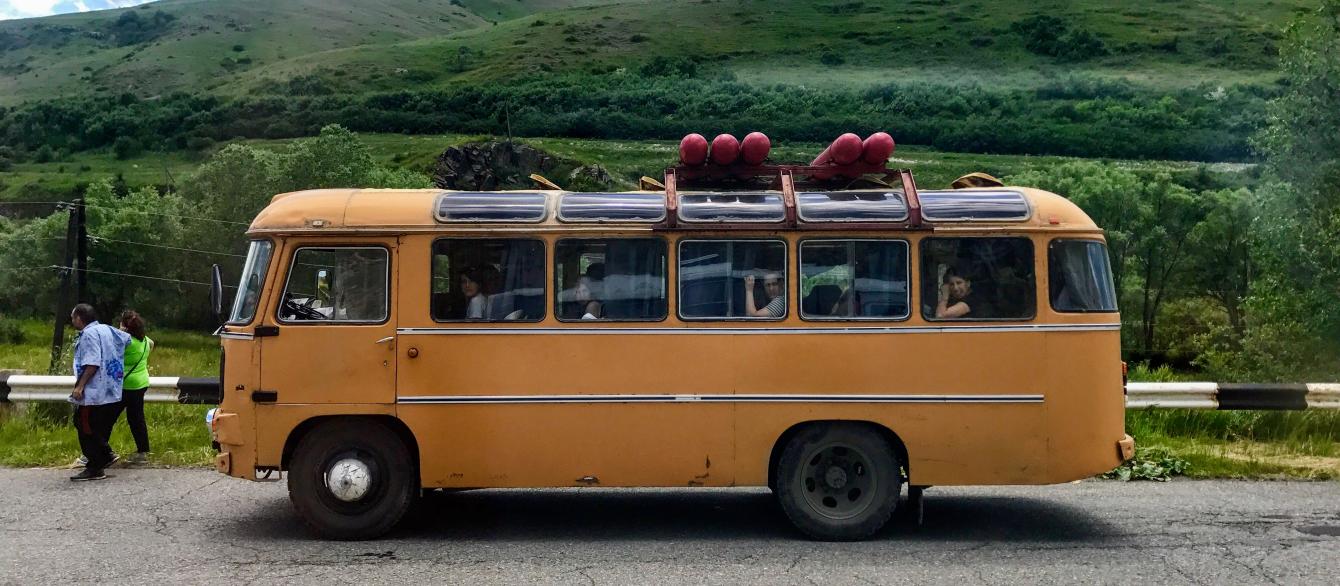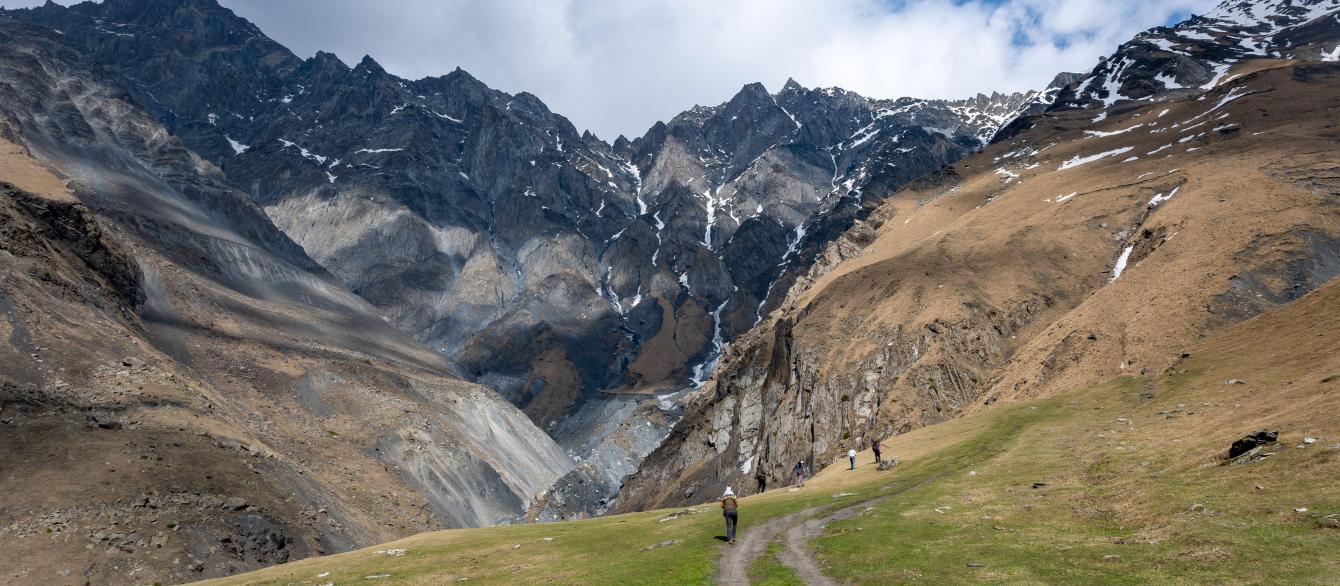Organizing conferences is a form of scholarly choreography. It requires a fair amount of logistical wrangling, a startling amount of intellectual labor, and a smattering of luck. But when it is done well, the experience has the capacity to shift the way participants think and write and teach.
At the end of April 2021, Danielle Leavitt-Quist and Anna Ivanova, Ph.D. candidates in History, hosted a conference on late Soviet history at the Davis Center. They called on fellow graduate students to consider the “productive” aspects of the late Soviet Union and to explore the lived experiences of its people. And as they sifted through the stack of paper proposals that landed in their inboxes, the shape of a rising generation of scholarship came into focus.
Kelly O'Neill asked Leavitt-Quist and Ivanova to reflect on the conference, and they graciously agreed to share their thoughts.

Map showing the home institutions of conference participants.
O'Neill: When you began thinking about the conference, what goals did you have in mind? What did you hope to accomplish by bringing graduate students together in this way, at this moment?
Ivanova & Leavitt-Quist: We really wanted to take advantage of some of the constraints of the COVID year and bring graduate students together to showcase their work. In any other year we might not have tackled this kind of project, because it is a lot of work to coordinate the gathering of so many people from so many places. Given the virtual turn the year took, it seemed a more feasible task. Additionally, it seemed like a great moment to give graduate students an opportunity to meet each other, become acquainted with new work, and gain some experience talking about their own work. We wanted to create a conference that allowed for the maximum number of presentations while still prioritizing feedback. It felt very important to us that everyone who presented receive concrete feedback from someone working in their field. We deliberately invited young assistant professors who are not too far removed from graduate school to be our discussants. They did an excellent job of providing each presenter with a set of actionable critiques that will be helpful in revision. This was our main goal: to give as many graduate students as possible the opportunity to present and get meaningful feedback on their work, in a year when intellectual creativity has felt, for many, lackluster.
O'Neill: When you send out a call for papers, you never know what you are going to get. How closely did your sense of the "landscape" of current research match the range of topics represented in the applicant pool? Or, to turn the question around, how well, do you think, the applicant pool reflects the landscape of current research?
Ivanova & Leavitt-Quist: It was so exciting for us to learn what topics graduate students are working on. It was equally exciting to learn that there are graduate students all around the world (the Middle East, India, South America) working on issues related to the Late Soviet Union. I think our applicant pool gave us a good sense of which topics and subfields are attracting people right now. Approaches to the study of late socialism are becoming more nuanced and complicated. It is no longer just a story of stagnation and social control, but one of creativity and contradiction. Our applicant pool demonstrated that very clearly.
Approaches to the study of late socialism are becoming more nuanced and complicated. It is no longer just a story of stagnation and social control, but one of creativity and contradiction.
O'Neill: As we all know all too well, the coronavirus pandemic prevented international travel and closed most libraries and archives. Could you talk a bit about how graduate students have perceived and dealt with these challenges? I have this image in my head of graduate students, their research plans short-circuited, caught in an anxiety-producing no-man's-land between frustration and inspiration...
Ivanova & Leavitt-Quist: This anxiety-producing no-man's-land is exactly why we pushed forward with the conference. It has been a hard year for everyone, and as graduate students, we have sometimes felt like it was a wasted year in terms of professional and intellectual development. We wanted to create a space that would counteract that. One thing we saw in our own work and the work of conference applicants and participants is a general turn towards published sources, as those have been the main materials available to work with this year. People are using scanned newspapers, magazines, and primary source academic journals in new and creative ways and challenging the stigma often attached to them (the idea being that archival materials are the only truly impressive or telling sources). I'm glad to see that the pandemic has reoriented us to these other sources which still have so much rich and interesting history to tell us.
O'Neill: What, or when, is the "late" Soviet Union? What holds this term together or gives it substance?
Ivanova & Leavitt-Quist: We defined the late Soviet Union as being between 1953 and 1991. Often late socialism is not thought to begin until Brezhnev takes over in 1965, but we wanted to include the immediate years after Stalin's death because they are so rich and fascinating. I think what holds the term together is the palpable sense that there are two primary eras in Soviet history: the Stalin Era and the post-Stalin Era. Those eras are tied together by many things yet remain distinct. We chose to focus on the late Soviet Union because it is experiencing a research renaissance; it seems most young researchers focused on the USSR are interested, to some extent, in the decades immediately preceding the fall of the USSR. We are, too, and we wanted to see what kind of topical and theoretical frameworks are attractive to other graduate students like us.

4-kopek postage stamp from 1966 honoring the 50th anniversary of Barguzin Nature Reserve. On the left, a sable and Lake Baikal; on the right, a map of the reserve.
O'Neill: The focus of Panel 1 was the "Late Soviet Environment." I'd like to invite you to reflect on the panel. What were some of the takeaways? Were you able to identify any through-lines? Commonalities? Productive points of difference? Did listening to these papers prompt any new questions or give you any sharable insights into the state of the field of Soviet environmental history?
Ivanova & Leavitt-Quist: We would start by saying that Soviet environmental history is relatively new and very actively developing subfield, and we are very glad it had representation at our conference. Papers in this panel talked about various eco-regions such as Siberian taiga, Tajik cotton fields and Kazakh steppe. For me, one common thread was the impact the environment and especially environmental policies had on particular, often very vulnerable, social groups. Nicholas Seay showed how cotton production shaped the lives of rural Tajik cotton growers; Alexandra Noi discovered that participation in scientific expeditions in Siberia were a rare job opportunity for former Gulag-prisoners, not least because they were (or were considered to be) used to harsh weather conditions; Abigail Bratcher emphasized the role and agency of regional scholars in overcoming the destructive effects of the Virgin Lands Campaign on Kazakh soils. For us, these presentations once again illuminated an important role environment played in the relationship between the Soviet state and society.

Harvesting cotton in the Uzbek SSR, 1966.
We were glad to have a panel which showed that when we talk about the Soviet people we might be talking about anything from Russian Germans deported from Volga to Kazakhstan in the 1940s to young Tajik hippies in the 1970s.
O'Neill: Panel 2 brought together papers that touched on issues related to nationalities across the Soviet Union, from Belarus' to Central Asia. In what ways do you see the rising generation of scholars working differently on this fundamental topic than those who came before? Do you see methods evolving? sourcebases expanding or contracting? the language of analysis changing?
Ivanova & Leavitt-Quist: The idea that the Soviet Union was not just Russia but rather a whole bunch of different national groups would seem to be a commonplace and yet a great deal of research in our field still focuses just on Moscow and Leningrad. So we were glad to have a panel which showed that when we talk about the Soviet people we might be talking about anything from Russian Germans deported from Volga to Kazakhstan in the 1940s to young Tajik hippies in the 1970s. One of the methods crucial for at least two of the presentations was oral history. Anna Kozlova has interviewed Germans who emigrated to Germany from the Soviet Union before and after 1991 about their understanding of their Germanness, while Faruh Kuziev interviewed his own relatives in a small town near Dushanbe about what it meant for them to be Tajiks in the Soviet Union. The interview method proved very helpful in talking about Soviet identities, the topic central to all four papers in this panel. Indeed, one of the through-lines was the discussion of how national identities were not only created from above by various Soviet institutions but also how they were created and experienced from below. An intriguing case was a Belarusian musical band Pesniary, which Lizaveta Lysenka talked about in her presentation. The leader of the band came to Belarus’ from Siberia and initially did not know much about Belarusian culture. At first, the band imitated Western rock icons, such as Beatles, and used Belarusian folk motives and imagery as a kind of disguise. But gradually, they became a symbol of Belarusian national identity. Another exciting angle to discuss national identities was provided by Hilary Lynd, who compared the mobilization of ethnicity in Soviet Kirgizia and in South Africa in the same period. All four papers did an excellent job of combining the analysis of the state’s nation-building policies with a nuanced depiction of lived experiences.

Young women of Tajikistan, 1972.
O'Neill: Panel 3 focused on gender. I would love to know how you see this (sub)field developing. When scholars dig into topics such as fatherhood and feminism, do they end up building bridges (intentionally or otherwise) to other fields? Does the gender lens magnify the specificity of the Soviet context? And, of course, what were some of the ideas or insights you took away from these papers?
Ivanova & Leavitt-Quist: The question of the specificity of the Soviet context is crucial when we think about gender policies. One the one hand, the issues faced by women in the late Soviet Union were often the same as those experienced in the West. On the other hand, on paper the Soviet state promoted gender equality and women’s rights. So did these policies have any effect? These papers provided a lot of material to try to answer this question. Kateryna Ruban showed that the majority of Soviet doctors were women. They were often sent to work in rural areas and became power figures in the villages. “State feminism” also comes to mind when we think about the underground feminists described by Anna Sidorevich. Paradoxically, she noted, many of the topics covered in their samizdat almanac, such as double-burdens or single motherhood, were the same as those discussed in Rabotnitsa, the official Soviet magazine for women. State policies which protected women in case of divorce sometimes put Soviet men in a counter-intuitive position of weakness: Ekaterina Voronova examined letters fathers wrote to state institutions and journal editors complaining about high alimony payments. Finally, Emily Lobenstein’s presentation highlighted that such a controversial institution as the beauty pageant was unthinkable in the Soviet context (thanks again to “state feminism”) and became possible only during Perestroika with its fascination with capitalist practices. Overall, this panel helped build the necessary framework for meaningful comparison of gender issues in the Soviet Union and the West.

Nurses and a new mother in Sosnovoborsk (near Penza), 1957.
In the end, creativity was a signature of the topics and methods of the papers across all the conference panels, and we are so glad we created a space for expressing this explicitly.
O'Neill: I was intrigued by the title of the final panel, mainly because it placed "creativity" alongside "morality" and "spirituality." Panel titles have a logic all their own—I get that. But I wonder, in retrospect, whether the deployment of that particular word shaped the way you took in these three presentations. In my own mind, "creativity" conjures a nebulous image of individual agency and the making of remarkable things. Tell us a bit about the remarkable things unearthed in these papers. And, if you like, maybe you could say a few words about the value/utility/relevance of creativity as a force shaping research agendas and scholarly conversations in the field of late Soviet history?
Ivanova & Leavitt-Quist: The funny thing is that initially this was just a panel for papers which we wanted to include but which did not fit into the topics we had in mind. Reading through them we realized there were indeed some common threads and one of them was creativity. For Christopher Leger, creativity was a key characteristic of the New Soviet Man as understood during the Thaw. He argued that while the Stalin era emphasized high productivity (the Stakhanovite movement is a good example), the Khruschev era put much more stress on creativity and innovation. John Kennedy studied creativity not on the level of state discourse but rather on the level of everyday practices. He discovered a very original movement which existed in the late Soviet context: the “self-making auto-constructors” movement. It turns out hundreds, if not thousands, of people in the 1960s were building their own vehicles, often out of spare parts stolen from factories! Elena Romashko used the prism of creativity to explore the (mainly religious) art created after the Chernobyl catastrophe. She showed how Belarusian society coped with trauma through objects of, what she called, vernacular religion. So the papers in this panel worked very well together and made us all reflect on what creativity meant in the Soviet context. In the end, creativity was a signature of the topics and methods of the papers across all the conference panels, and we are so glad we created a space for expressing this explicitly.

From a collection of images documenting the work of automotive "homebrewers." This "faux Lada" dates from the 1970s.
O'Neill: Has the conference changed the way you think about—or go about—your own work?
Ivanova & Leavitt-Quist: The conference didn't change much about how we think about our own projects, but it certainly rejuvenated our interest in our own work. Truthfully, that is the best outcome anyone can really wish for. Seeing how other graduate students were approaching their work and getting a good sense of why their subjects and stories move them to write was motivating. Curiosity and creativity are often infectious, and the conference certainly had that effect on us.
Endnote
When we asked participants what followed, for them, in the wake of the conference, their replies echoed what Anna and Danielle had shared about connection and perspective. Participants talked about the value of questions they could not (yet) answer and the jolts of inspiration they drew from methods they had not (yet) considered. Some talked about the pleasure of listening to others—of getting outside one’s own head—and many talked about the rich reward of discussant feedback.
None of this is terribly surprising, but as we begin to reclaim a sense of normalcy in the aftermath of a difficult year, perhaps it is the right moment to remind ourselves that as much as we love books and archives and algorithms, we are part of a human community. We—all of us—need moments like this. We need opportunities to speak and to listen. To float ideas. Respond to stimuli. Reduce the distance between the strange and the familiar. Confirm what we know and what we do not.
We need, above all, to seek each other out.
And if we can accomplish such things while shaping the future of Soviet history? All the better.








